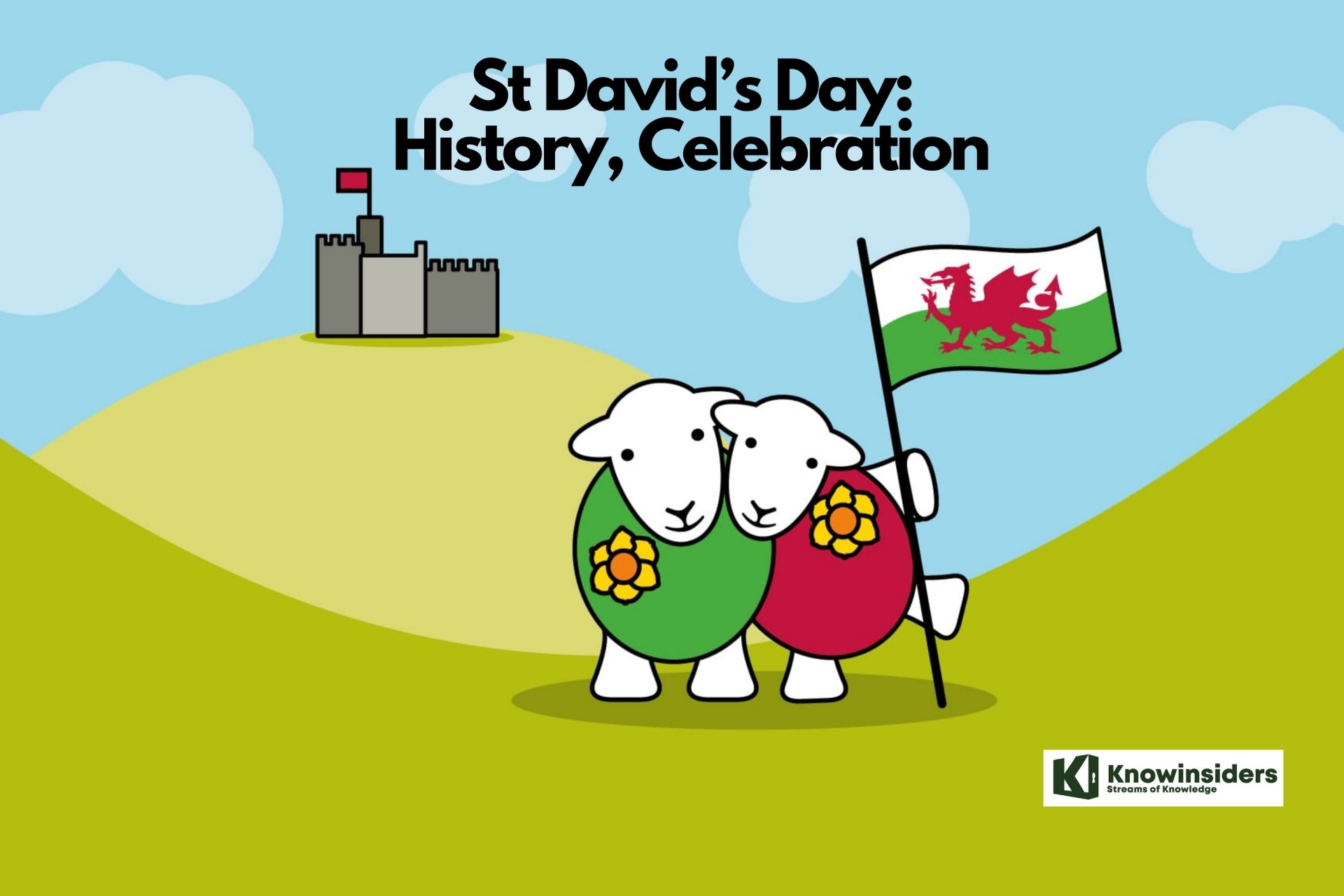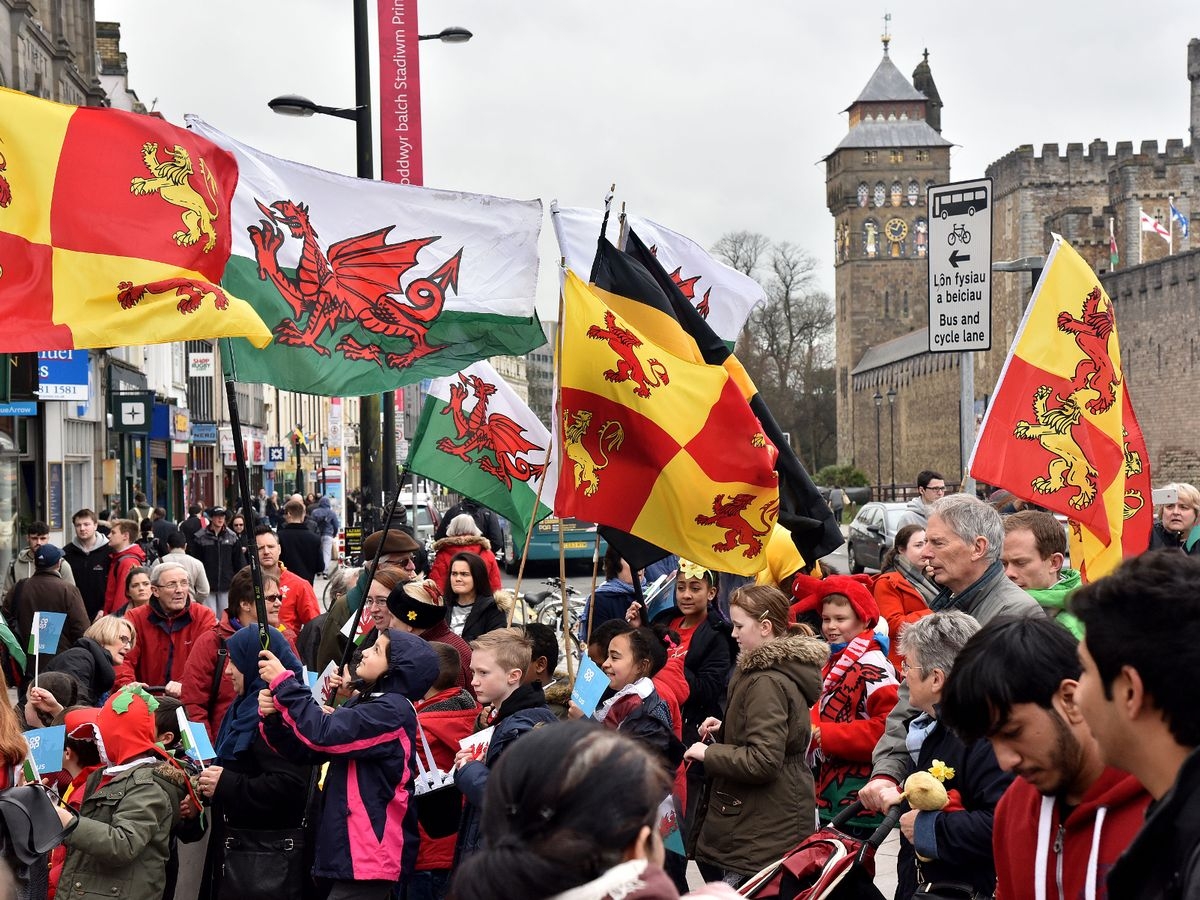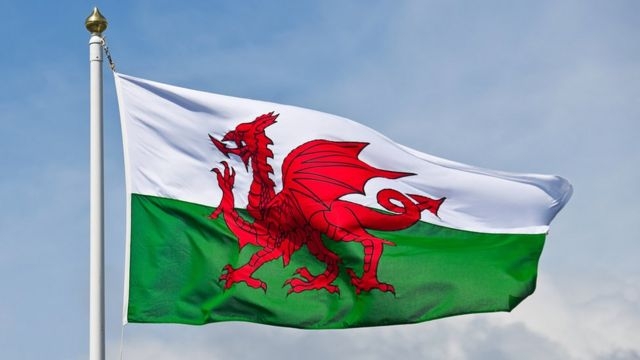St David’s Day: History, Celebration and Who is St David?
 |
| St David’s Day. Photo: KnowInsiders |
St. Davids Day is currently only a patron saint day and does not have any legal standing. Meanwhile, in Scotland and Ireland St Andrew’s Day and St Patrick’s Day respectively are already public holidays.
Usually, St David’s Day is a day of parades, concerts and eisteddfodau (festivals of music, language and culture). Flags are flown. The national anthem is sung with extra fervour. Children go to school in traditional Welsh dress, and everyone (well, almost…) proudly pins a daffodil or leek to their lapel.
St. David's Day History
March 1st is St. Davids Day, the national day of Wales, and has been celebrated as such since the 12th Century. Today the celebrations usually involve the singing of traditional songs followed by a Te Bach, a tea with bara brith (famous welsh fruited bread), and teisen bach (welsh cake). Young girls are encouraged to wear national costume and leeks or daffodils are worn, being the national symbols of Wales.
So who was St. David (or Dewi Sant in Welsh)? Actually not too much is known about St David except from a biography written around 1090 by Rhygyfarch, son of the Bishop of St. Davids.
David was reputedly born on a cliff top near Capel Non (Non’s chapel) on the South-West Wales coast during a fierce storm. Both his parents were descended from Welsh royalty. He was the son of Sandde, Prince of Powys, and Non, daughter of a chieftain of Menevia (now the little cathedral town of St David’s). The site of Davids birth is marked by the ruins of a tiny ancient chapel close to a holy well and the more recent 18th century chapel dedicated to his mother Non can still be seen near St. David’s Cathedral.
In medieval times it was believed that St David was the nephew of King Arthur. Legend has it that the patron saint of Ireland, St. Patrick – also said to have been born near the present-day city of St. Davids – foresaw the birth of David in approximately 520AD.
The young David grew up to be a priest, being educated at the monastery of Hen Fynyw under the tutorage of St. Paulinus. According to legend David performed several miracles during his life including restoring Paulinus’ sight. It is also said that during a battle against the Saxons, David advised his soldiers to wear leeks in their hats so that they could easily be distinguished from their enemies, which is why the leek is one of the emblems of Wales!
A vegetarian who ate only bread, herbs and vegetables and who drank only water, David became known as Aquaticus or Dewi Ddyfrwr (the water drinker) in Welsh. Sometimes, as a self-imposed penance, he would stand up to his neck in a lake of cold water, reciting Scripture! It is also said that milestones during his life were marked by the appearance of springs of water.
Becoming a missionary David travelled throughout Wales and Britain and even made a pilgrimage to Jerusalem where he was consecrated bishop. He founded 12 monasteries including Glastonbury and one at Minevia (St. Davids) which he made his bishops seat. He was named Archbishop of Wales at the Synod of Brevi (Llandewi Brefi), Cardiganshire in 550.
Monastery life was very strict, the brothers having to work very hard, cultivating the land and pulling the plough. Many crafts were followed – beekeeping, in particular, was very important. The monks had to keep themselves fed as well as provide food and lodging for travellers. They also looked after the poor.
St David died on 1 March 589A.D., at Minevia, allegedly over 100 years old. His remains were buried in a shrine in the 6th-century cathedral which was ransacked in the 11th century by Viking invaders, who plundered the site and murdered two Welsh bishops.
After his death, his influence spread far and wide, first through Britain and then by sea to Cornwall and Brittany. In 1120, Pope Callactus II canonised David as a Saint. Following this he was declared Patron Saint of Wales. Such was Davids influence that many pilgrimages were made to St. David’s, and the Pope decreed that two pilgrimages made to St. Davids equalled one to Rome while three were worth one to Jerusalem. Fifty churches in South Wales alone bear his name.
It is not certain how much of the history of St. David is fact and how much is mere speculation. However in 1996 bones were found in St. David’s Cathedral which, it is claimed, could be those of Dewi himself. Perhaps these bones can tell us more about St David: priest, bishop and patron saint of Wales.
How is St David’s Day celebrated?
 |
| Photo: Wales Online |
St David’s Day celebrations will be held in cities and towns all across Wales. The Welsh are famous for their poetry and singing so there will be lots of that, as well as parades and castle tours. You’re sure to see Wales’s national animal, Y Ddraig Goch – the Red Dragon – out on the streets.
There are many ways which you can celebrate St David’s Day, even if you are not in Wales. For example, you can buy a bouquet of daffodils because the daffodil is a symbol of Wales. Or you could put on your apron and make some Welsh cakes or cheesy Welsh rarebit. If you’re up for a challenge, try learning the Welsh national anthem – it’s sung in the Welsh language!
Do the little things
Follow the words of St David himself: gwnewch y pethau bychain — do the little things. What better way to celebrate than to bring those words to life with an outpouring of hwyl and kindness. Celebrate St David's Day by doing and sharing Random Acts of Welshness.
Visit St Davids' HQ in Pembrokeshire
Established by our patron saint in the 12th century, pretty St Davids in south-west Pembrokeshire doesn’t have much in common with places like Birmingham or London. But thanks to the presence of its huge, purple-stoned cathedral, this settlement of around 2000 people is officially the UK’s smallest city. It’s also the religious centre of Wales, with two trips here said to be worth one pilgrimage to Rome.
Events across Wales
The National Trust is a reliable source of lavishly-daffodilled gardens and St David’s Day events. Most of their sites in Wales will be honouring St David in one way or another. The good people who look after our castles and ancient monuments, Cadw, also arrange special events at many of their locations, sometimes including free entry - check their website for latest details.
Our seven national museums also join the party, with a host of interactive and entertaining events across Wales.
Head to St David’s Hall in Cardiff (where else?) for an afternoon of stirring Welsh song. It’s a thoroughly Welsh affair with big name musicians and orchestras playing Welsh favourites new and old.
Be the king of the castle
You can hardly move for castles here. At the last count we had more than 600 fabulous fortresses dotted across our landscape. These include big hitters like the UNESCO World Heritage Site castles at Beaumaris, Caernarfon, Conwy and Harlech, plus lesser-known spots like lonely Llansteffan, Dolbadarn and Castell y Bere built by native Welsh princes. If you want to get a closer look at some of these iconic Welsh sites, we’ve got you covered. To celebrate St David’s Day, Cadw is offering free entry to many of our historic places. Storming the ramparts couldn’t be easier.
St. David's Day festivities and traditions
 |
| Photo: BBC |
Celebrated every year on the 1st of March, St. David’s Day festivities occur in a variety of ways.
For children this can involve a half-day off from school, depending on the area and the school in question. Unfortunately, St. David’s Day isn’t officially a UK Bank Holiday.
Children take part in what’s called eisteddfodau, meaning “sitting together”. This is a festival with judged competitions for poets, musicians, and others in the arts. People also don traditional costumes, often involving the wearing of both a leek and/or a daffodil.
As you may already know the daffodil is the national symbol of Wales, but the leek may seem more obscure. The wearing of the leek arises from a time when some Welshmen were battling with the English. Both sides wore similar uniforms. So it goes that the Welsh were able to distinguish each other from the English by wearing leeks.
Part of the traditional attire for St. David’s Day may also include the wearing of a Welsh Hat. This is like a top hat but taller, and sometimes sloped towards the top.
What symbols are associated with St David's Day?
 |
| Photo: Bournemouth Echo |
On St David's Day, many people in Wales pin either a daffodil or a leek to their clothes - as the Welsh have two national emblems.
The tradition of eating and wearing leeks on St David’s Day supposedly goes back to the 6th century.
The soldiers of the British king Cadwaladyr were encouraged to wear leeks in their helmets to help them recognise fellow countrymen during a battle with the Saxons, explains Wales Online.
St David was a teetotal vegetarian reputed to have consumed only leeks and water.
But Historic UK says it's likely the Welsh association with the leek predates St David by hundreds and possibly thousands of years, to an age when people worshipped trees, plants and Mother Nature.
This pre-dated Christianity - at a time when Druids lived on the Island of Anglesey.
Leeks were hailed as a cure for the cold, protecting soldiers against wounds in battle, and even for keeping away evil spirits.
Entries in the household accounts of the ‘Welsh’ Tudor Kings of England, record payments for leeks worn by the household guards on St David’s Day.
Earlier in the fourteenth century, it is known that the feared Welsh archers adopted the green and white colours of the leek for their uniforms, perhaps at the Battle of Crecy, explains Historic UK.
In 1346, when the Prince of Wales, Edward the Black Prince, defeated the French at the Battle of Crécy, Welsh archers reportedly fought bravely in a field of leeks and as a reminder began to wear a leek in their caps every St David's Day.
Daffodils, which are in bloom around this time of year, have only became another national symbol for Wales in the 19th century.
Wales Online explains that St David's feast day became a national festival during the 18th century.
It states: "By that time the leek had become a bit of a caricature and this may explain why daffodils became a popular alternative."
| Why is St David’s Day not a public bank holiday in Wales? A petition calling for St David’s Day to be made a national bank holiday in Wales, which gathered thousands of signatures, was rejected by Downing Street in 2007. A poll conducted in 2006 indicated that 87% of the Welsh public were in support of this change. With other countries, including Ireland and Scotland getting chance to celebrate their national days with a public holiday, it only seems fair that Wales get the chance to as well. |
 Mardi Gras Day: Date, Time, Traditions Mardi Gras Day: Date, Time, Traditions Mardi Gras, also known as Fat Tuesday or Shrove Tuesday is celebrated popularly in New Orleans and some places in the world. |
 World Backup Day: Date, Celebration And Importance Of Backup World Backup Day: Date, Celebration And Importance Of Backup Have you backed up your data recently? Every day people, businesses, even games lose huge amounts of valuable data because they fail to follow this ... |
 Chocolate Cake Day: Date, Celebration and History Chocolate Cake Day: Date, Celebration and History There is a day for chocolate cake lovers, which is 27 January. Be ready for a chocolate cake party on this day. |


























